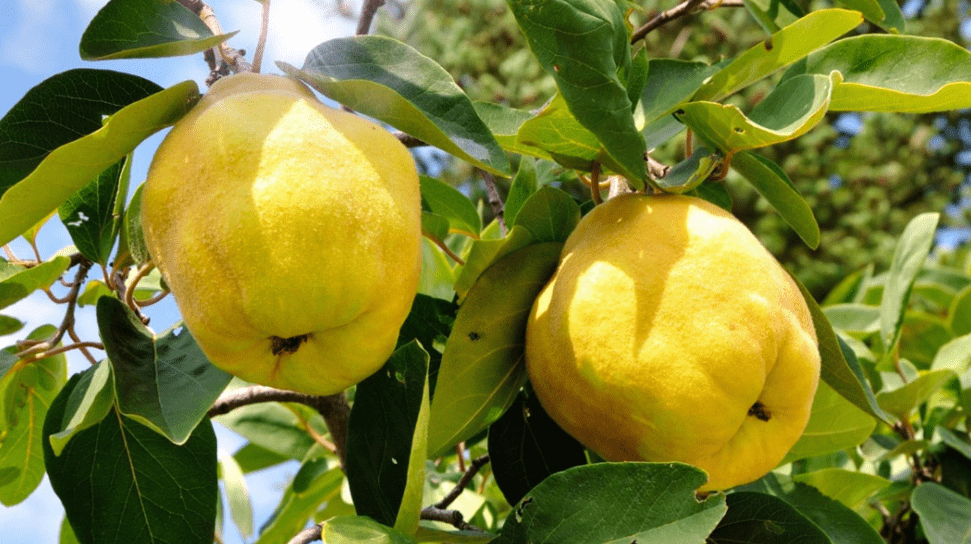
Quince Fruit Tree: Transform Your Garden with This Exotic Fruit
The quince fruit tree is a unique and exotic addition to any garden, offering not only beautiful blooms but also delicious and versatile fruit. In this post, we’ll explore the benefits of adding a quince fruit tree to your garden and provide tips on how to care for and maintain this lovely tree. We’ll also delve into the various delicious uses of quince fruit and how it can enhance your garden and culinary experiences. Whether you’re a seasoned gardener or just starting out, the quince fruit tree is a delightful addition that can transform your garden in many ways.
Table of Contents
ToggleUnderstanding the Quince Fruit Tree
A. Overview of the quince tree (Cydonia oblonga)
The quince fruit tree, also known as Cydonia oblonga, is a deciduous tree that is prized for its stunning blooms and aromatic fruit. It is a member of the rose family and is native to Southwest Asia and Southeastern Europe. The tree can grow up to 15-20 feet tall and has a spreading growth habit, making it an attractive addition to any garden
B. Description of quince fruit
The quince fruit is similar in shape to a pear, with a golden yellow to green color when ripe. It has a firm texture, and a unique, floral aroma that adds a delightful fragrance to any garden. The fruit is high in pectin, making it an excellent choice for jams, jellies, and preserves. It can also be used in baking, poaching, and even making homemade liqueurs.
C. Different varieties of quince
There are several different varieties of quince, each with its own unique characteristics. Some popular varieties include the Pineapple quince, which has a sweet, pineapple-like flavor, the Champion quince, known for its large and aromatic fruit, and the Smyrna quince, which is prized for its high pectin content and suitability for cooking. Each variety offers a slightly different taste and texture, providing options for different culinary uses.
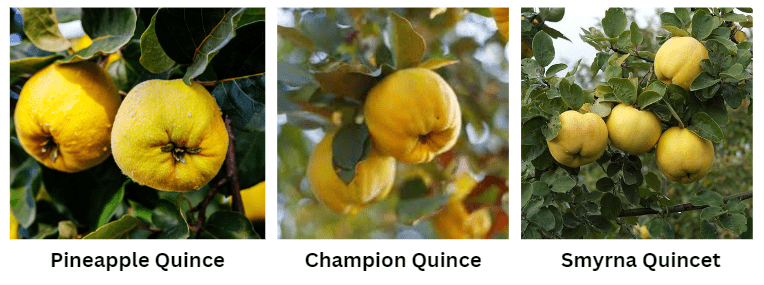
Choosing the Right Quince Tree
A. Selecting the right variety for your region
When selecting a quince tree, it’s important to consider the climate and soil conditions of your region. Quince trees thrive in temperate climates with cold winters and warm summers, so it’s important to choose a variety that is suitable for your specific climate zone. Additionally, quince trees require well-drained soil with a pH of around 5.5 to 6.5, making it important to consider the soil conditions of your area when choosing a variety. Overall, it’s important to select a quince tree variety that is well-suited to the climate and soil conditions of your region in order to ensure successful growth and fruit production.
B. How to source quality quince saplings
When sourcing quince saplings, it’s important to ensure that they come from a reputable nursery or supplier. Look for saplings that are healthy and disease-free, as this will give your tree the best chance of success. It’s also a good idea to consider purchasing grafted saplings, as these have been grown from a rootstock that is known to be compatible with the chosen quince variety, ensuring a stronger and more productive tree. Additionally, it may be helpful to seek out recommendations from local gardeners or agricultural experts to find a reliable source for high-quality quince saplings. By carefully selecting where to source your quince saplings, you can increase the likelihood of a successful and productive quince tree.
C. Factors to consider (disease resistance, size, yield)
When selecting quince saplings, it’s important to consider several factors to ensure you get the best outcome. Disease resistance is a key consideration, as it can affect the overall health and productivity of the tree. Look for varieties that are known for their resistance to common quince diseases such as fire blight and leaf spot.
Size is another important factor to consider. Depending on the space you have available, you may want to choose a variety that is well-suited to your specific growing conditions. Some quince varieties may be more compact, making them suitable for smaller gardens, while others may be more vigorous and better suited to larger spaces.
Finally, consider the yield of the quince tree. Some varieties are known for their high fruit production, while others may produce smaller or fewer fruits. Consider your own preferences and needs when selecting a variety based on yield.
By carefully considering these factors, you can ensure that you select the best quince saplings for your specific needs and growing conditions.
Planting Your Quince Tree
A. Best time to plant quince trees
The best time to plant quince trees is in the late fall or early spring when the soil is cool and moist. This allows the roots to establish themselves before the tree enters the active growing season. Avoid planting during hot, dry periods, as this can stress the tree and hinder its establishment. It’s also important to choose a sunny location with well-drained soil for optimal growth.
B. Step-by-step planting guide
Step 1: Test the soil pH and amend it if necessary to ensure it falls within the optimal range for quince trees, which is around 5.5-6.5.
Step 2: Remove any weeds or debris from the area and consider adding organic compost or fertilizer to the soil to provide essential nutrients for the tree.
Step 3: Ensure that the planting site receives adequate sunlight, as quince trees thrive in full sun conditions.
Step 4: Dig a hole that is wide and deep enough to accommodate the tree’s root system and carefully place the tree in the hole, ensuring that the root flare is at or slightly above ground level.
Step 5: Water the tree thoroughly after planting and continue to water regularly, especially during dry periods.
Step 6: Mulch around the base of the tree to help retain moisture and suppress weeds.
Step 7: Prune the tree as needed to remove dead or damaged branches and shape the tree.
Following these steps will help ensure that your quince tree gets off to a healthy start and thrives in its new environment.
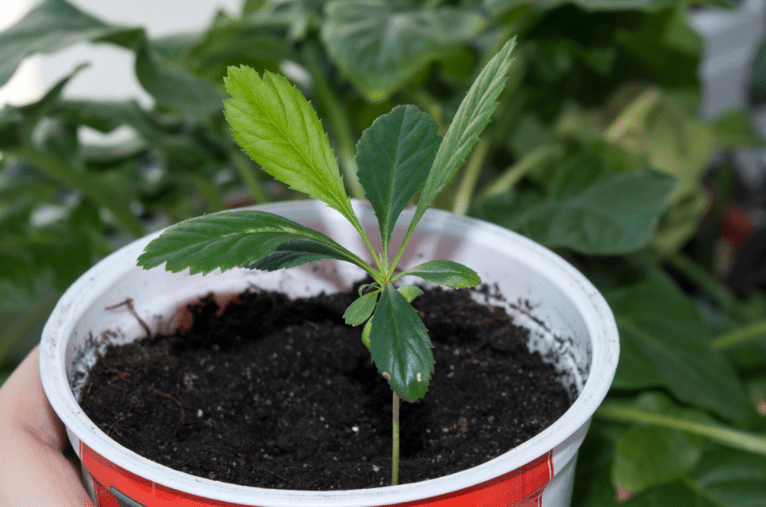
Care and Maintenance
A. Watering requirements
Quince trees require regular watering, especially during dry periods. It’s important to water the tree thoroughly after planting and continue to water it on a regular basis to ensure it stays healthy. Additionally, mulching around the base of the tree can help retain moisture and suppress weeds, which can also help with the tree’s watering needs.
B. Fertilizing your quince tree
It’s important to fertilize your quince tree to ensure it gets the nutrients it needs to thrive. You can use a balanced fertilizer in the spring, and again in the summer if needed. Be sure to follow the dosage and application instructions on the fertilizer packaging to avoid over-fertilizing.
C. Pruning techniques
Pruning your quince tree is important for maintaining its shape, improving air circulation, and promoting fruit production. It’s best to prune your tree in late winter or early spring before new growth begins. Remove any dead or damaged branches, as well as any crossing or crowded branches. It’s also a good idea to prune the center of the tree to open it up to sunlight and air. Proper pruning techniques can help your quince tree stay healthy and productive.
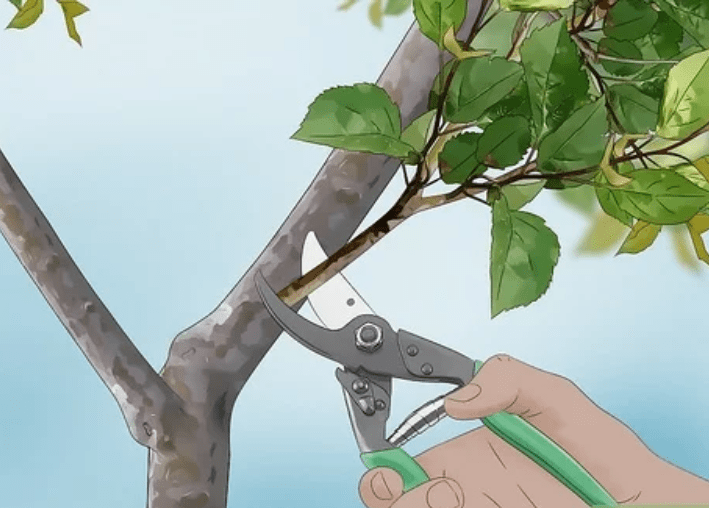
D. Pest and disease management
Pest and disease management is essential for maintaining the health and productivity of your quince tree. Regular inspection of the tree for signs of pests or diseases is important. Common pests that can affect quince trees include aphids, scale insects, and spider mites, while diseases such as fire blight, powdery mildew, and quince rust can also be problematic.
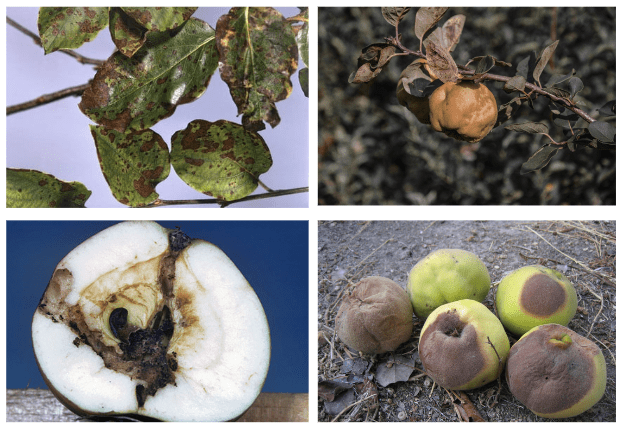
1. Organic and chemical control methods
There are both organic and chemical control methods available for managing pests and diseases on quince trees. Organic methods may include introducing natural predators, such as ladybugs, to control aphid populations, or using neem oil to combat scale insects and spider mites. Chemical control methods often involve the use of insecticidal soaps or horticultural oils, as well as fungicides to manage diseases.
2. Timing and frequency of treatments
It’s important to time and apply treatments properly to effectively manage pests and diseases. For example, spraying insecticidal soaps or horticultural oils should be done when pests are in their most vulnerable stage, and fungicides should be applied preventatively before disease symptoms appear. Additionally, it’s important to follow the recommended frequency of treatments to ensure ongoing control.
3. Integrated pest management
Integrated pest management (IPM) involves using a combination of cultural, biological, and chemical control methods to manage pests and diseases. This approach emphasizes monitoring and prevention, as well as minimizing the impact on beneficial insects and the environment. Implementing an IPM program can help effectively manage pests and diseases while reducing the need for chemical treatments.
Harvesting Quince Fruits
A. How to determine when quince fruits are ripe
Quince fruits are typically ready to harvest when they have turned from green to a golden yellow color and have a fragrant aroma. The fruits should also feel slightly soft to the touch. It’s important to handle the fruits carefully to avoid bruising them. Once harvested, quince fruits can be stored in a cool, dry place for several weeks.
B. Harvesting techniques
When harvesting quince fruits, it’s best to gently twist and lift the fruits from the branches to avoid damaging the delicate skin. It’s important to handle the fruits with care to prevent bruising. Avoid pulling or tugging on the fruits, as this can cause damage. It’s also important to use clean and sharp pruning shears to cut the fruits from the tree, leaving a small stem attached to the fruit. This will help prolong the fruits’ shelf life. After harvesting, be sure to store the quince fruits in a cool, dry place to preserve their freshness.
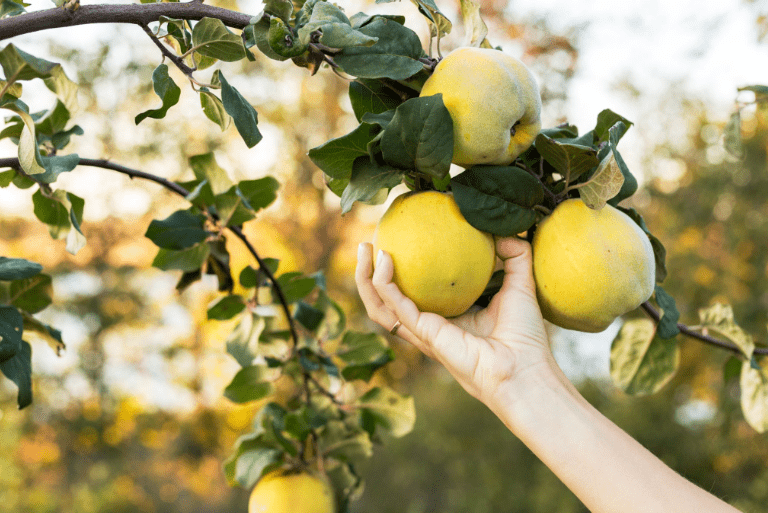
C. Storing and ripening post-harvest
When storing quince fruits after harvesting, it’s important to keep them in a cool, dry place to prevent them from spoiling. Ideally, they should be stored at temperatures between 32-40°F (0-4°C). It’s also important to store them in a single layer to prevent them from bruising or rotting. Quinces can ripen further after harvesting, so it’s best to check them regularly and remove any fruits that have become overripe. If you want to speed up the ripening process, you can place them in a paper bag with a ripe banana or apple to help them ripen faster. This will help ensure that you can enjoy your quince fruits at their peak freshness.
Uses of Quince Fruit
A. Culinary uses
Quince fruits have a variety of culinary uses. They can be used to make quince paste, jams, jellies, and compotes. They can also be added to savory dishes such as stews or roasted meats for a unique and sweet flavor. Quince fruits can also be used to make desserts such as tarts, pies, and crumbles. Additionally, they can be used to flavor and sweeten beverages such as teas and cocktails. Overall, quince fruits are a versatile ingredient that can be used in a wide range of culinary applications.
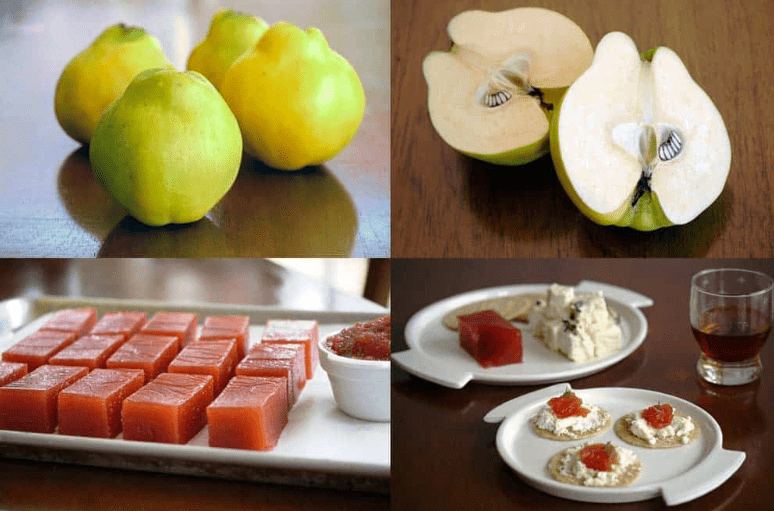
B. Medicinal uses and health benefits
Quince fruit has been used for its medicinal properties and health benefits for centuries. It is rich in vitamins, minerals, and antioxidants that can help boost the immune system and improve overall health. Quince fruit is also known for its anti-inflammatory properties, which can help reduce the risk of chronic diseases and improve digestive health. Additionally, quince fruit is high in dietary fiber, which can aid in digestion and help maintain a healthy weight. It has also been used in traditional medicine to treat coughs, colds, and gastrointestinal issues. Overall, quince fruit can be a beneficial addition to a healthy diet and has been used for its medicinal properties for generations.
C. Craft and ornamental uses
Quince fruit is also commonly used for craft and ornamental purposes. The fruit’s unique shape and fragrance make it a popular choice for decorative arrangements and centerpieces. Its vibrant color and attractive appearance also make it a popular choice for adding a decorative touch to dishes and desserts. In addition, quince fruit can be used to make jams, jellies, and preserves, adding a touch of flavor and color to various culinary creations. Overall, quince fruit is not only valued for its health benefits but also for its decorative and culinary uses.
Troubleshooting Common Problems
A. Identifying and addressing issues with growth and fruiting
If you are experiencing issues with the growth and fruiting of your quince tree, there are a few common problems that you may be facing. One common issue is inadequate sunlight, so make sure your tree is receiving at least 6-8 hours of direct sunlight per day. Another issue could be poor soil drainage, so consider improving drainage or transplanting your tree to a better location. Additionally, improper pruning or fertilization can also hinder growth and fruiting, so make sure to follow proper care guidelines for your quince tree. By addressing these common problems, you can help promote healthy growth and abundant fruiting for your quince tree.
B. Solutions for poor yield or fruit quality
If you are experiencing poor yield or fruit quality with your quince tree, there are a few solutions that you can consider. One common issue that could be affecting yield and fruit quality is inadequate pollination, so consider planting additional trees to improve cross-pollination. Another possibility is nutrient deficiencies, so make sure to properly fertilize your tree with a balanced fertilizer. Additionally, pest infestations or diseases can also impact fruit quality, so monitor your tree for any signs of pests or diseases and take appropriate action to address them. By implementing these solutions, you can help improve the yield and quality of the fruit from your quince tree.
Companion Planting and Garden Design
A. Best companion plants for quince trees
Some of the best companion plants for quince trees include herbs such as thyme, mint, and sage, as well as flowering plants like marigolds and lavender. These plants can help attract beneficial insects, improve soil health, and provide natural pest control for your quince tree. Additionally, consider planting cover crops such as clover or vetch to help suppress weeds and improve overall soil fertility. When designing your garden, ensure that the companion plants are spaced appropriately to avoid competition with the quince tree and provide the right growing conditions for each plant. By incorporating these companion plants into your garden design, you can create a healthy and thriving environment for your quince tree.
B. Designing a garden layout with quince as a focal point
When designing a garden layout with quince as a focal point, it’s important to consider the mature size of the quince tree and plan accordingly. Choose companion plants that will complement the quince tree and enhance its overall aesthetic appeal. You can create a visually pleasing garden by planting smaller shrubs or perennials around the base of the quince tree to add texture and color. Consider adding a variety of herbs, flowers, and ground covers to create a diverse and visually appealing garden around the quince tree. Additionally, ensure that the garden design allows for easy access to the quince tree for maintenance and harvesting. By carefully selecting companion plants and arranging them in a thoughtful manner, you can create a beautiful and harmonious garden layout with the quince as the focal point.
Quince in Landscaping
A. Ornamental value of quince trees
Quince trees offer significant ornamental value in landscaping due to their beautiful, fragrant blossoms in the spring and attractive fruit in the fall. Their unique and striking appearance can serve as a focal point in a garden design, adding visual interest and enhancing the overall aesthetic appeal of the landscape. Additionally, quince trees can provide seasonal interest and create a welcoming and inviting atmosphere in the garden. With their versatility and ornamental value, quince trees can be a valuable addition to any landscape design.
B. Seasonal interest (flowers in spring, fruit in autumn)
Quince trees offer seasonal interest throughout the year, making them a desirable choice for landscaping. In the spring, they produce beautiful and fragrant blossoms that add color and charm to the garden. In the fall, they bear attractive fruits that can add a pop of color and texture to the landscape. This seasonal variation allows for year-round visual interest and keeps the garden looking vibrant and dynamic. By carefully selecting companion plants and arranging them thoughtfully, you can create a beautiful and harmonious garden layout with the quince tree as the focal point, ensuring a stunning and diverse display throughout the seasons.
In conclusion, adding a quince fruit tree to your garden can not only enhance the beauty of your outdoor space, but it can also provide you with delicious and versatile fruit. With proper care and maintenance, you can enjoy a bountiful harvest of quince fruit and explore various culinary uses for this exotic fruit. Whether you’re making quince jam, adding it to your baked goods, or simply enjoying it fresh, the quince fruit tree can truly transform your garden and add a unique touch to your homegrown produce.
Frequently Asked Questions (FAQs)
A quince fruit tree is a tree that produces quince fruit, which is a unique and exotic fruit with a strong, aromatic fragrance and a tart flavor.
Quince fruit trees require full sun and well-drained soil. They should be pruned regularly to maintain their shape and encourage fruit production. They also benefit from regular watering and fertilization.
The best time to plant a quince fruit tree is in the late fall or early spring, when the tree is dormant. This will give it time to establish its roots before the growing season begins.
Quince fruit trees typically start producing fruit 3-5 years after planting. However, the quality and quantity of the fruit may increase as the tree matures.
Quince fruit can be used to make jams, jellies, and preserves, as well as baked into pies and tarts. It can also be added to savory dishes for a unique and tangy flavor.
Quince fruit trees are generally hardy and resistant to most diseases and pests. However, they may be susceptible to fire blight, so it’s important to monitor the tree for any signs of disease and treat it accordingly.
Yes, quince fruit trees can be grown in containers, but they will require regular pruning and maintenance to keep them at a manageable size. Make sure the container has good drainage and provide the tree with adequate sunlight and water.
Some varieties of quince fruit trees are self-pollinating, but others may require a second tree for cross-pollination in order to produce fruit. It’s important to research the specific variety of quince tree you have to determine its pollination needs.
